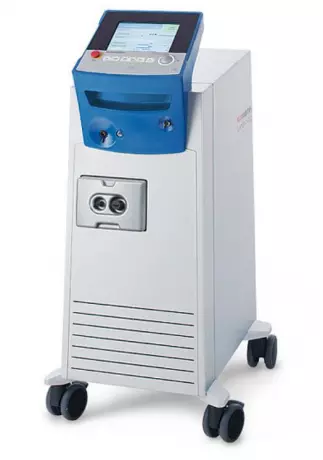
Surgical laser systems In the early 1990s, we started developing the first laser surgery devices....
Portal and digital medical technology fair of the largest MedTech cluster in Germany

In general medicine, the laser is mainly used in diagnostics, e.g. for measuring blood flow (flowmetry) and circulation. There are also low-level laser therapy devices available for treating wounds and pain.
In ophthalmology, laser light with different wavelengths is used, the wavelength, exposure time (exposure time) and energy influencing the physical reaction and depth of penetration. The argon laser is used to prevent coagulation (e.g. in the case of diabetic retinopathy, thrombosis) with its thermal effects or to carry out retinopexy (welding of tissue layers in the case of retinal holes or detachment). The neodymium-YAG laser and the Femto-LASER use the high-energy, ultra-short suprapulse and the excimer laser, through their own phenomenon of tissue evaporation (photoablation / sublimation), to cause a precise, narrowly defined tissue tear (photodisruption), a reshaping of the corneal surface (e.g. PRK or LASIK) to eliminate the ametropia. Femtosecond laser cataract surgery is a new method in cataract surgery that is extremely precise in several important steps during this procedure. In addition, three-dimensional imaging processes such as optical coherence tomography (OCT) or online pachymetry, optical path measurement and photo documentation of all eye structures with a resolution in the micrometer range are possible with the laser.
In surgery, vascular surgery and phlebology, the laser is mainly used in endoscopy or as a laser scalpel. Another application is the treatment of defective veins (varicose veins). The laser can be used endovenous (laser light guide is inserted into the vein). This laser treatment method replaces the removal of the vein with "stripping". In many cases the laser treatment is gentler and can be carried out on an outpatient basis. In dermatology, cuts and sclerotherapy can be performed with laser beams. Blood vessels can be coagulated by lasers of specific wavelengths. Pigment spots can be removed or specifically destroyed with the help of ablative (= peeling) lasers. Subcutaneous (= under the skin) pigment can be destroyed with the help of an ultra-short pulse laser and thus removed without seriously damaging the skin surface. By using long-pulsed lasers, hair roots can be permanently destroyed by epilation. Lasers are also used for the targeted treatment of inflammatory skin diseases, especially psoriasis. For the cosmetic improvement of the skin's appearance, superficial bumps in the skin (nodules, wrinkles) are smoothed out (resurfacing). Laser light can also be used for targeted heating of the skin areas, which is primarily intended to build up the collagen to tighten the skin ("subsurfacing").
In ear, nose and throat medicine, lasers are used to remove changes in the vocal cords during microlaryngoscopy and to partially remove the tonsils (tonsillotomy) and tumors in the mouth and throat (e.g. in tongue cancer). In otosclerosis surgery, lasers are used to perforate the stapes footplate. In dentistry, lasers can be used to remove hard tooth substance ("drilling without a drill") or in periodontics (germ reduction and concretion removal from inflamed gum pockets). Diode lasers are used in dentistry for surgical interventions, e.g. lip frenulum removal, for germ reduction in endodontics (root canal treatment) or for teeth whitening (bleaching). Advantages of laser treatment compared to the conventional method are that the patient feels less pain, the setting of sutures is sometimes superfluous, less bleeding occurs because the wound is sclerosed and the treated area is decontaminated (germ-free) at the same time. In some cases, however, better studies with a higher level of evidence are needed to assess the benefits of the laser.
In cancer therapy it is used for photodynamic therapy; in urology for the treatment of kidney and ureter stones as well as the prostate. Laser microdissection is a process for obtaining the smallest samples from tissue sections or cell cultures. Techniques that are still being explored include: Attempts to use laser light to specifically grow nerves.
Become a digital exhibitor yourself in the online portal of the largest and best-known MedTech cluster region in Germany and inform the world of medical technology about your products and services as well as about news, events and career opportunities.
With an attractive online profile, we will help you to present yourself professionally on our portal as well as on Google and on social media.